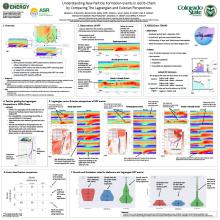Understanding New Particle Formation Events in GEOS-Chem by Comparing The Lagrangian and Eulerian Perspectives
Samuel
O'Donnell
CSU
Poster
New particle formation (NPF) is the process by which new ultrafine-particles are formed from gas-phase precursors. NPF is the dominant source of global aerosol number and a major contributor to global cloud condensation nuclei (CCN) concentrations. The availability of CCN affects Earth’s climate through the modulation of cloud formation, lifetime, and brightness. Most NPF observations have been at stationary sites. However, NPF observed from stationary sites may not adequately capture the isolated effects of aerosol chemistry and physics, due to gradual or rapid changes in the air masses passing over the site. In this work, we compare modeled aerosol size distributions at stationary sites and along Lagrangian trajectories crossing the sites during NPF events. We run a 3-D chemical transport model (GEOS-Chem) over the central United States for 2019, and compare aerosol size distributions with measurements at the Southern Great Plains (SGP) observatory, OK. The model represents changes in aerosol number and component mass due to condensation/evaporation, coagulation, and nucleation across 40 size bins ranging from 1 nm to 10 𝜇m. We examine days where particles appear at the stationary sites already grown or where early nucleation is observed but particle growth is not apparent. For events where particles appear already grown at the stationary sites, the Lagrangian trajectories show more typical ‘banana’ type NPF events, indicating that NPF and growth is occurring upwind of the stationary sites. For events with little to no growth at the stationary sites, the Lagrangian trajectories indicate that subsequent particle growth is occurring downwind. In this work, we will present an analysis of several NPF events with discrepancies between the stationary and Lagrangian size distributions, and we will examine the implications of these discrepancies.

Odonnell-Samuel-poster.pdf
(1.23 MB)
Meeting homepage
